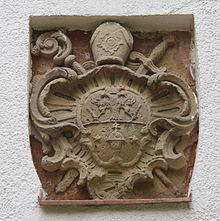Heyerberg Chapel
The Heyerberg Chapel (also called Borler Chapel ) is a neo-Romanesque chapel completed in 1875 , which is located about 1,200 meters southwest of Borler , a local community in the Vulkaneifel district ( Rhineland-Palatinate ). It stands on the wooded Heyerberg and has been a protected cultural monument since 1992 .
history
Even before 1600 there was a castle chapel on the Heyerberg , which served as the burial place of the Lords of Heyer. Around the chapel there was a cemetery for the servants from Haus und Hof Heyer, as well as for the citizens of Borler. The buildings of the Lords of Heyer and the chapel were released as a quarry and demolished in the first half of the 19th century in the course of secularization . In 1874 the construction of the current Heyerberg Chapel began. The new building was initiated as a will from a citizen of Borl, endowed with a donation of 365 thalers. The consecration took place on September 13, 1875. In 1952 the chapel was extensively restored.
architecture
The three- axis hall with a semicircular apse was dedicated to the painful Mother of God . Above the portal is the stone coat of arms of the Imperial Abbey of St. Maximin , which was formerly attached to the courtyard door of Hof Heyer . The arched window openings are closed with ornamental leaded glass windows . On the sloping gable roof of the ship sits a roof turret , which is crowned by a cross.
Furnishing
The altar by Seibert Maur from Leudersdorf is dominated by a Pietà from a workshop in Trier. On the right and left are statues of St. Leonhard and John the Baptist . The double-wing door was made in the course of the restoration by the carpenter Alois Daniels from Bodenbach as a foundation (in gratitude for undamaged return from the battle of Stalingrad and the subsequent Soviet prisoner-of-war).
Way of the Cross
At the chapel there is a way of the cross with 14 stations created in 1878 . Some of the grave crosses that have been preserved from the old cemetery are set up on the way from Borler up to the Heyerkapelle (see also List of cultural monuments in Borler ). Even today, the so-called "Fosslächer" ( footfalls ) are prayed on these crosses in a pilgrimage to the chapel when someone from Borler has died.
Individual evidence
literature
- Festschrift for the parish festival in Nohn on the occasion of the 200th anniversary of the current Church of St. Martin and the 180th parish anniversary in 1981 . Ed. By Parish Council Nohn, Nohn 1981, pp. 57–58.
Web links
Coordinates: 50 ° 18 ′ 18 ″ N , 6 ° 48 ′ 56 ″ E




